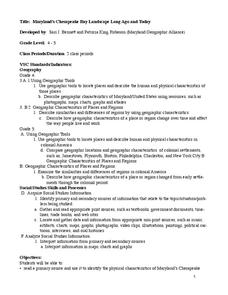Curated OER
Say It Loud!: A Celebration Of Black Music In America Music In America
Students study early New Orleans Jazz music and recognize Louis Armstrong as an early jazz artist. They recognize the elements and roots of Jazz.
Curated OER
The Cold War and Development of Post-War America
Young scholars view examples of political advertisements during the years of 1952 through 1964. After viewing, they discuss how the Cold War and the threat of Communism affected the development of the United States. They compare the...
Curated OER
JAPAN, IMAGES A PEOPLE
Students interpret Japanese and American paintings; evaluate paintings as sources of cultural and historical information
Curated OER
A Rising People: Ben Franklin and the Americans
Learners examine the Enlightenment Era and its philosophies, including philosophers. Students gain an understanding concerning what they new science was and what it led to through a series of lessons and a PowerPoint. the end by writing...
Curated OER
Exploring the Roots of Modern Dance in America
Students develop an understanding of how African culture impacted modern dance in the United States.
Curated OER
On the Run: What Was Necessary To Plan an Escape From Slavery in 18th Century America?
Students identify and discuss characteristics of runaway slaves in 18th Century, read A Narrative of the Adventures and Escapes of Moses, select five advertisements for Virginia Runaways Digital Project to complete On the Run worksheet,...
Curated OER
Rockin’ the World: Rock and Roll and Social Protest in 20th Century America
Students explore protest songs. In this interdisciplinary lesson, students examine issues-based music by summarizing lyrics and revealing inferences, generalizations, conclusions, and points of view found in the songs.
Curated OER
The Most American Thing in America: The Chautauqua
Students explore the Chautauqua movement. For this Pennsylvania history lesson, students use primary documents to explore what the Chautauqua was and how it made a difference in the American way of life.
Curated OER
America's Heartland
Students complete geography and trade activities about global trade. In this geography and trade lesson, students read information to learn about absolute advantage, comparative advantage, trade factors, U.S. trade partners, and...
Curated OER
Japan: Images of a People
Students learn the geography of Japan and its location in reference to the United States.
Curated OER
Famous People and Cultural Diffusion
Students use the internet to identify cultural traditions throughout the world. In groups, they examine each culture and determine the effect they had on life in the United States. They use this information to write a family history...
Curated OER
Help Wanted! Jobs in Ancient America
Students are introduced to the various occupations in Mesopotamia. In groups, they discuss the reasons for occupations changing over time. They use the internet to research the ancient jobs of their choice and write a paper discussing...
Curated OER
The 1970s in America
In this 1970s worksheet, 9th graders answer ten questions with a word or phrase, decide which event (in three different pairs) occurred first, then link two groups of words together by writing what they share in common.
Curated OER
Why Did America Lose the Vietnam War?
In this Vietnam study guide worksheet, learners locate reasons that the United States lost the Vietnam War. Students respond to 3 short answer questions based on their worksheet as well as their textbook reading.
Curated OER
Slavery in America at the Time of the Civil War: Navigating a Website
Students discover how to navigate websites. In this Civil War instructional activity, students conduct research on slavery as they visit a website to experience oral, written, and digital texts and performances by slaves from the Civil...
Curated OER
Jamestown Celebrates 400th Anniversary
Students view a world map and identify the locations of England and Virginia and discuss what kinds of things they would take with them on this kind of trip. They read the words in the news box on the student page and fill in the blanks...
K12 Reader
Import/Export
The reading passage here uses the example of the American colonies to introduce imports and exports. After reading the text, class members respond to five questions, which require pupils to find facts in the text and form opinions about...
Curated OER
Maryland’s Chesapeake Bay Landscape Long Ago and Today
Combine a fantastic review of primary source analysis with a study of Captain John Smith's influence on the Chesapeake Bay region in the seventeenth century. Your young historians will use images, a primary source excerpt, and maps...
Montana State University
One Mountain, Many Cultures
Americans may think of Mount Everest as a region dedicated to adventurous hikers, but many cultures have flourished there! Learners read informative books, watch videos, participate in classroom discussion, analyze folk tales, and...
Smithsonian Institution
American Sabor Crossword
How much do you know about Latin American music? A crossword puzzle challenges learners to answer 24 questions about the history, genres, performers, and instruments of Latin American music.
Curated OER
Living Yesterday's History Today
Students describe and contrast life as it was in colonial days. They plan, compose, and produce a student movie. They reflect on what they have learned. They share their experience with others in digital format.
Curated OER
Finding James Fort
Welcome to Jamestown! Third and fourth graders read and analyze primary source documents about Jamestown or Fort James. They read and analyze descriptions of Fort James from primary sources. They access a website to explore more...
Stanford University
Expansion of the Inca Empire
If you could write your own history textbook, what would you include? Learners play the role of textbook writers by examining evidence of the Inca Empire. With primary sources from Spanish and indigenous perspectives, as well as images,...

























